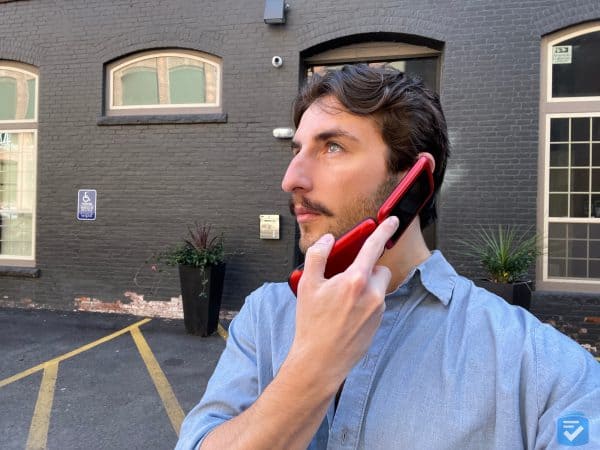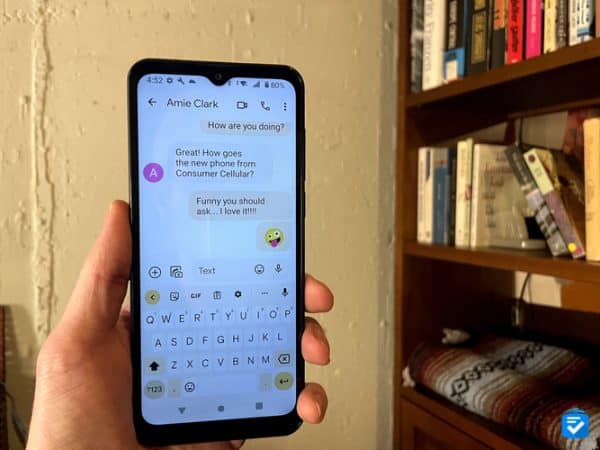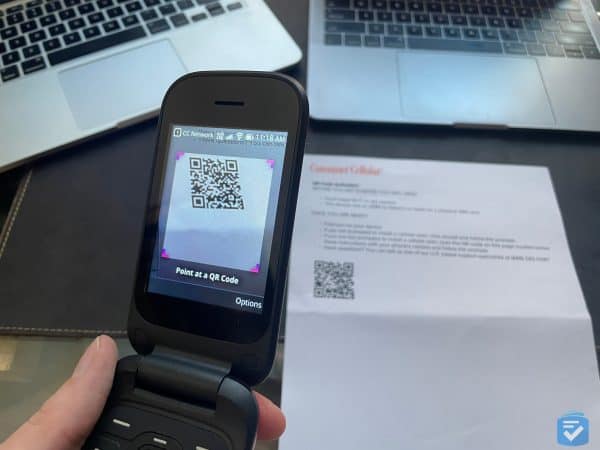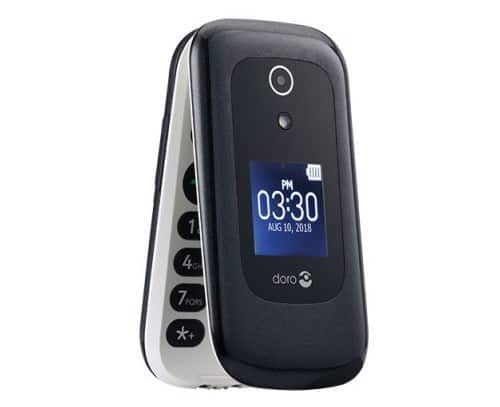
Consumer Cellular: 2024 Reviews

While the major cellular carriers (Verizon, AT&T, and T-Mobile) charge upwards of $50 per month for their most basic plans, Consumer Cellular offers veritable bargains, starting at $20 per month for unlimited talk, unlimited text, and 1GB of data. This begs the question: What’s the catch?
In this Consumer Cellular review, I’ll recount my experience purchasing service with this provider and using it in my daily life. I’ll also provide a detailed rundown of its costs and how its network functions. Overall, I found that while data speeds can fluctuate with this network, its low costs ultimately make it worth the price of entry.

Pro Tip: Looking for the perfect cell phone? Then check out my lists of the best cell phones for seniors and best cell phone plans for seniors.
Consumer Cellular Pros and Cons
What We Like About Consumer Cellular
- Low-Priced Plans: Starting at just $15 for their basic, talk-only plan, Consumer Cellular offers plans at a highly competitive price point. For $20 per month, you can get unlimited talk, unlimited texts, and 1 GB of data.
- No Long-Term Contracts: Unlike many traditional wireless providers, Consumer Cellular did not lock me into a long-term contract. Each of its plans is paid on a month-to-month basis, and I could upgrade my service or cancel it without paying any fees or penalties.
- Wide Range of Devices: From basic flip phones to the newest models from Apple and Samsung, Consumer Cellular’s offerings run the full gamut of cell phones. They even allow customers to put their own phones on their service, provided they use SIM cards.
- Roadside Assistance: In addition to affordable cell phone plans, Consumer Cellular lets you add Roadside Assistance for just $3 per month.
What We Didn't Like
- No Prepaid Options: While I appreciated that Consumer Cellular doesn’t require long-term contracts, it would have been nice to have the option to prepay for service. When providers allow this option, it means that any unused minutes can accumulate rather than disappear at the end of each pay period.
- Confusing Return Policy: Many of our readers have reported being unable to return devices, even when they were in their original condition.
The Purchasing Process
Ordering a phone through Consumer Cellular is just about as easy as it gets. In addition to Target and some independent retailers, Consumer Cellular devices and plans can also be purchased online.
On Consumer Cellular’s website, I was able to view each of their plans and phones.
Choosing a Cellular Plan
In the past, Consumer Cellular offered plans with strictly talk and text. Recently, the provider has streamlined their offerings. Now, all of their plans come with unlimited talk and text. The difference between each plan will be the amount of data allowed.
Additional lines cost an additional $15 per month, and all of the lines will share the same data allowance.
Additionally, although not listed on its website, Consumer Cellular also has a talk-only plan for $15 per month. To subscribe to this plan, you’ll have to contact Consumer Cellular through the phone. That said, this plan only offers 300 minutes per month, so we think this won't be the best fit for most users.
Consumer Cellular Plans
| Monthly Cost for One Line | Talk and Text | Data |
| $15 |
|
None |
| $20 | Unlimited | 1GB |
| $35 | Unlimited | 10GB |
| $50 | Unlimited | Unlimited |
Consumer Cellular Unlimited AARP Plan
As of 2023, Consumer Cellular now offers a special discounted plan for AARP members. This plan comes with two lines of unlimited talk, text, and data for $55 per month. At $27.50 per line, this is definitely one of the most affordable unlimited plans available for seniors.
To sign. up for this plan, you need to purchase two lines, and you need to be an AARP member.
Ultimately, I decided to sign up for Consumer Cellular’s Unlimited Talk and Text plan with Unlimited Data, which would normally cost $50 per month. However, Consumer Cellular offers discounted rates for additional lines. Since I purchased three lines for myself and my children, the total cost for my service plan came to only $30 per month per line, meaning my grand total for service was $80 a month.
FYI: For only $15 a month, you can add one or more phones to any existing Consumer Cellular plan, making it both easy and affordable for couples and families to share a wireless plan.
Consumer Cellular Phones

Consumer Cellular offers an impressive array of phones, ranging from simple flip phones to the latest offerings from Samsung, Motorola, and Apple. I can safely say that they have something to satisfy almost any taste or need. For example, there’s my father, an older man who has had the same flip phone since the early aughts. It frustrates him that even though he needs a new phone, his major carrier no longer offers simple devices made for calling and texting only. Fortunately, Consumer Cellular has a user-friendly flip phone known as the Consumer Cellular Iris Flip, which fits the bill.
On the other end of the spectrum, Consumer Cellular offers the iPhone 14 Pro Max with a retina display and cinematic mode to the Samsung Galaxy A12 in 32GB with an ultra-wide lens to capture memories. They even offer their very own smartphone with an easier to use interface, the Iris Connect.
While it’s easy to assume that these types of cutting edge smartphones supersede the needs of most older adults, I wouldn’t be so quick to assume. Studies show that roughly half of seniors with cell phones have smartphones, and the older people that I know get more technologically advanced by the year.
Ultimately, I decided to test out three different phones from Consumer Cellular, the Doro 7050, the iPhone SE, and the Samsung Galaxy A12. Each of them had their own unique set of features, but more on that below.
Keep Your Phone: If you happen to already be using a phone on another network, you can transfer this device to a Consumer Cellular plan with one of their SIM cards, included when you sign up for a service plan.
Consumer Cellular currently offers 28 phones. Check out our detailed chart for a breakdown on pricing below.
| Brand | Model | One-time Payment |
|---|---|---|
| Consumer Cellular | Iris Flip | $69 |
| Nokia | C110 | $99 |
| Consumer Cellular | ZMax 11 | $99 |
| Nokia | C300 | $129 |
| Motorola | Moto G Play | $149 |
| Samsung | Galaxy A03s | $159 |
| Consumer Cellular | ZMax 5G | $169 |
| Samsung | Galaxy A14 5G | $199 |
| Nokia | G400 5G | $217 |
| Motorola | Moto G Edge 5G | $249 |
| Motorola | Moto G Stylus 5G | $329 |
| Apple | iPhone SE 3rd Gen | $429 |
| Samsung | Galaxy A54 5G | $449 |
| Apple | iPhone 11 | $499 |
| Samsung | Galaxy S22 | $699 |
| Apple | iPhone 13 | $729 |
| Motorola | Edge+ | $799 |
| Samsung | Galaxy S23 | $799 |
| Apple | iPhone 14 | $799 |
| Apple | iPhone 14 Plus | $899 |
| Apple | iPhone 14 Pro | $999 |
| Samsung | Galaxy S23+ | $999 |
| Samsung | Galaxy Z Flip4 | $999 |
| Apple | iPhone 14 Pro Max | $1,099 |
| Samsung | Galaxy S23 Ultra | $1,199 |
| Samsung | Galaxy Z Fold4 | $1,799 |
Consumer Cellular Setup

If you’ve ever activated a cell phone before, then have no fear because Consumer Cellular’s setup process is just about the same as any other network. If you haven’t ever activated a cell phone, well, the process is easy as pie. In about one week, each of my phones was shipped to my home. I unboxed them and plugged them into the included chargers. Once they had fully charged, all I had to do was call a number on the back of the box, confirm my information with the support team, and then start using them.
How My Phones Worked
In terms of phones, I purchased the Doro 7050, the iPhone SE, and the Samsung A12. Between the three of these phones, I got a good sense of the range of options from Consumer Cellular. Let’s take a closer look at each of them:
Doro 7050 ($50 One Time Payment)

This is one of the most affordable options that Consumer Cellular has, and it’s one of two phones that feature the classic clamshell design of yore. I’ve got to say, there’s something I missed about the tactile experience of a flip phone, perfect for an older adult who wants to stick to the basics. For starters, its buttons are actually raised rather than on a touch screen, and they’re backlit so I could see them even in the dark. With nearly half of people over the age of 65 suffering from arthritis, the size and spacing of these buttons made it easy to dial a number or type out a text message. When I made calls with it, I noticed the volume of the receiver was appropriately loud and clear.
Additionally, the exterior of this phone featured an assistance button, which, when I pressed it, called a number that I had chosen, which happened to be my husband. However, it could also be another emergency contact or service like the police. This feature in particular made this phone seem like an ideal option for older adults. Sure, the Doro 7050’s 3MP camera wasn’t going to help me win a Pulitzer in photography, but for those of us looking for a simple way to remain connected on the go, the Doro 7050 is a solid option.
FYI: If you’re looking for a great flip phone, check out my Jitterbug Flip2 review and my list of the best flip phones for seniors.
iPhone SE ($399 One-Time Payment)

Originally released back in 2016, the iPhone SE packed in enough features to impress me, though my technophile kids looked at the thing as though it were a fossil. Regardless, I appreciated its 12MP camera, which captured photos in accurate coloration. In addition, the smartphone had the intuitive menu screens that I’ve come to expect from Apple products. But what about the phone itself? Well, I’m happy to report that the actual phone portion of this smartphone worked beautifully. The audio quality was crystal clear, even when I took the phone on bike rides through the wilderness. Plus, even though it operates through a touch screen, I rarely found myself pressing the wrong button, although this could be an issue for those with arthritis.
While Apple says that the SE’s battery life lasts for 26 hours of call time, my phone seemed to last even longer during testing. For the more adventurous buyer, someone looking for not just a cell phone but also a camera, music player, and television, the iPhone SE is a good choice. Even if the idea of using a smartphone is a bit intimidating, the SE’s intuitive design made it easy to explore its wide array of features.
Samsung Galaxy A12 ($179 One-Time Payment)
Similar to the iPhone SE, the Galaxy operates primarily through its 6.5” touch screen; however this phone features a higher resolution, which came in handy while browsing the web for complicated dinner recipes. With up to 32GB of internal storage and Bluetooth and voice recognition capabilities, this device is user-friendly and great for older adults who want to stream music or stay connected with loved ones. The camera is perhaps one of the best features of this device because it is able to help older adults take clear, crisp pictures while making new memories with loved ones. With an 8.0MP front-facing camera and an ultra wide lens, this device is a must-have for everyday use.
Savings Tip: For most of its devices, Consumer Cellular allows you to purchase RFG-certified returned items, pre-owned devices that have been refurbished and can cost around $100 less than the new factory versions.
Consumer Cellular vs. T-Mobile
In terms of unlimited phone plans for seniors, both T-Mobile and Consumer Cellular are among our favorites. In fact, both providers offer a plan with unlimited talk, text, and data for seniors that costs $27.50 per month, per line.
In our experience, T-Mobile will offer faster data speeds, since it owns its own wireless network. Consumer Cellular, however, leases T-Mobile’s network (as well as that of AT&T), so in times of heavy usage, Consumer Cellular users may experience slowed data speeds.
On the other hand, Consumer Cellular offers more affordable basic plans with solely talk and text.
To read our full comparison of these two providers, read our guide: T-Mobile vs. Consumer Cellular.
We've also compared Consumer Cellular to a number of other providers:
Consumer Cellular AARP Discount
For over a decade, Consumer Cellular has been an official partner of AARP, meaning that current members of this group receive a 5% discount on their monthly fees.
Now, I’m not an AARP member just yet, but let’s say for the sake of argument that I was. Since my monthly service charge from Consumer Cellular was $80, this would have added up to an annual savings of $48.
In addition to this generous discount, AARP members receive an extended 45-day money back guarantee on their devices and service plan, 15 days more than that of regular customers. Trust me, I’m counting down the days until I’m eligible for membership and all that it has to offer!
Bottom Line
When it comes to cellular service providers geared toward older adults, Consumer Cellular is a solid choice. Its breadth of phone compatibility ensures that there’s a device for just about any taste or ability level, and the straightforward nature of its service plans takes the headache out of an industry often filled with hidden fees and complicated contracts.
Arguably, the only thing missing from Consumer Cellular would be more robust features for medical alert functionality, like the kind that’s built into the Jitterbug Smart4; however, for those looking for a simple and affordable way to have a cell phone, Consumer Cellular has just what you’re looking for.
If you’d like to see some of our other favorite wireless providers, check out my reviews of T-Mobile plans for seniors and Verizon senior plans.
Consumer Cellular FAQ’s
-
Does Consumer Cellular charge overage fees?
Instead of overage charges, Consumer Cellular automatically upgrades you to a plan that covers the amount of data you’ve used. For example, if you’re using a plan with 1GB of data, and you go over this amount, they’ll simply upgrade you to the next plan.
-
Do you get free minutes on nights and weekends?
As of 2023, all of Consumer Cellular’s plans include unlimited talk, so there’s no need to keep track of your calls and texts.
-
With Consumer Cellular, can I keep my existing cell phone number?
Depending on your current service provider, you most likely can transfer your existing number to Consumer Cellular’s network. Just be sure to undergo the transfer process before canceling with your current service provider. This way, the number will remain active so that Consumer Cellular can guide you through the process.
-
Does Consumer Cellular have a plan with just talk and text?
Yes, although the plan is not listed on their website, Consumer Cellular has a plan with unlimited talk for $15 per month. To sign up for this plan, you’ll have to call Consumer Cellular.


